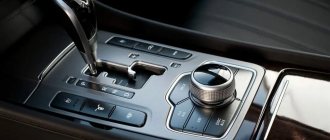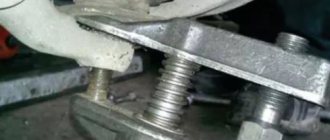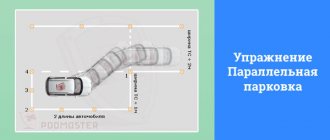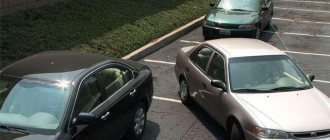Hello, friends! Any motorist can get into an accident or become involved in an accident. This does not depend 100% on experience, skills, and the ability to make quick decisions in difficult situations. Interestingly, reversing out of a parking lot often causes a collision.
The number of accidents in parking lots and parking lots is impressive. At the same time, when faced with a collision on a regular road, drivers usually know how to act. If the situation occurs in a parking lot (parking lot), then the participants are lost.
Distances are short, there are many vehicles. It's hard to keep track of everything going on around you. According to statistics, it is when you back out of a parking lot that the largest number of accidents occur.
Learn the rules
So what do you need to know about this? How can a novice car enthusiast reverse out of a parking lot? First, you should pay attention to the traffic rules. Clause 8.12 of the Russian Traffic Regulations allows reversing only under the condition of maximum safety of the maneuver. The driver is also prohibited from interfering with other road users.
Other participants are persons who are directly involved in the movement process. This category includes drivers, passengers, and pedestrians. Who and to whom should yield while driving in a parking lot? In relation to cars, the rule of interference on the right remains relevant. The driver is also obliged to allow absolutely all pedestrians to pass.
Driving in reverse using mirrors
When you have mastered driving backwards with your head turned, you can continue to train only with the use of mirrors. First you need to adjust the mirrors correctly. The owner of the vehicle is obliged to control the situation happening behind him and this must be done with the help of rear-view mirrors. Having acquired good skills, all motorists use only mirrors and no longer turn their heads.
First of all
How can a beginner reverse out of a parking lot? A person must understand what troubles careless movement can entail. For example, people may suddenly appear behind a vehicle, in the blind spot of the mirrors. There could also be another car driving there, or someone’s luggage.
The main task of a motorist is to protect himself from all this. First, you need to at least briefly inspect your car, pay attention to the wheels and make sure that they are not flat. Then you should devote time to your “neighbors” in the parking lot. It is possible that at this very moment someone is also preparing to leave.
Reversing in a parking lot
A reader’s question about the situation of reversing in a parking space located in an area equipped for this purpose, in other words, in an organized parking lot. Such parking lots are located in adjacent areas; they are most often multi-row, and parking spaces are located with the possibility of driving between the rows.
Entering the parking area and parking the car (into a parking space) usually does not raise any questions. Some people park in front, while others find it more convenient to drive straight into the exit, i.e. A car enters a parking space in reverse.
The convenience of leaving a parking space depends on the availability of free space around the car (mainly in front or behind it, since you always have to leave either forward or backward, and taking into account the space for maneuver on its sides).
In this regard, the question is: if two cars back out of their parking spaces into a common driveway and collide, which of them will be at fault?
Answer. In general, it is advisable to formulate the question not “who will be to blame”, but “how not to collide” in this situation. How not to collide, more on that later, but first, the answer to the question.
When an accident occurs between participants, one of whom was reversing, then in general cases the driver whose car was reversing will be found guilty of the accident. If both cars were driving backwards and collided, then both drivers should respond accordingly.
Paragraph 8.12 of the traffic rules: “Reverse movement of a vehicle is permitted provided that this maneuver is safe and does not interfere with other road users...”. Other traffic participants include persons directly involved in the movement process as a driver, pedestrian, or passenger.
In general, careless reversing in a parking lot can cause a lot of trouble. For example, behind the car, in the “dead” zone (the blind spot of the mirrors), there may be people, someone’s “luggage” may be lying (standing), another car may be driving, and its driver will certainly be in a hurry somewhere! Those. Anything can happen around you.
How to reverse out of a parking lot correctly and without incident
Or how to protect yourself when leaving a parking space in an organized parking lot in the adjacent area? Mini-instructions.
You should start with a quick visual inspection of the car upon return. It always makes sense to pay attention to the tires (if they are flat). Next, you should pay attention to your “neighbors” in the parking lot - is anyone getting ready to drive away in the next minute? At the same time, outline your route: how to get out, which way to turn, how to taxi out.
Before you start reversing out of a parking lot, you should check (look around) the space behind the car and both sides of the driveway (left and right). You need to make sure that there is no traffic behind you in the parking lot (no one is fussing behind the car, and no one is going to drive towards you). When you are sure that the exit is clear, you can start driving, having first turned on the appropriate turn signal.
If you are leaving a parking space in reverse and turning to the right, you need to turn on the right turn indicator, but if you are leaving in reverse and turning to the left, then turn on the left turn indicator. Next, you drive between the rows to the general exit point. That, in fact, is all the “tricks”.
These rules apply to any places suitable for parking vehicles: in organized parking lots, near shops, shopping centers, adjacent territories, in courtyards and other places.
When leaving a parking lot in reverse, you need to take into account the physics of turning a car: the rear (non-steering) wheels move out first, and the front wheels steer (turn) the car. “Back” and “front” change places, therefore, there is no need to rush to turn the steering wheel too early when leaving.
First, you pull out of the parking space on “straight” wheels, then, when the front wheels leave the “pocket,” turn the steering wheel in the right direction, otherwise you risk hitting a neighboring car with your front bumper. To have a general understanding of this situation, you need to understand the dynamic dimensions of your car. Following the link and in the article Parallel parking there is a diagram of the movement of the front wheels and the car body when turning.
In addition to the material presented above, I suggest that you familiarize yourself with previously published articles on a very similar topic - reversing movement and maneuvers:
Starting by car - options for leaving near sidewalk parking
Leaving a parking lot in reverse - exiting in a situation with limited visibility (answer to the question).
Driving a car. Part 9. Parking - dynamic dimensions of the car and methods of parking the car.
In general, parking requires attention and more attention. Don't rely only on rear view mirrors. You need to not be lazy, turn your head and look around to “check” the blind spot of the mirrors; there is no other way. Well, where you can’t see it at all, it makes sense to get out of the car and look, so to speak, from your height.
Before you start driving
How to reverse out of a parking lot without harming yourself and others? To begin with, you should map out your route. A beginner should think in advance about how to get out, how to taxi, where to turn. Next, you should look at both sides of the driveway (right and left), as well as the space behind the car. This will help ensure there is no traffic in the parking lot.
If the exit is clear, you are allowed to start moving. Be sure to turn on the appropriate turn signal.
Let's start practicing driving in a straight line
Every skill needs constant training. As a result, before leaving for the city, practice proper driving in reverse. First, you need to master driving in a straight line without using mirrors. To do this, turn your head back and control everything that happens on the road through your right shoulder. It should also be remembered that correct driving in a straight line will depend on the position of the steering wheel. Even with slight movement of the steering wheel, the car will move to the sides. In this regard, it is very important to drive at low speeds.
How to reverse out of a parking lot: step-by-step instructions
At this stage, the driver is also required to be extremely careful. He must be ready to press the brake pedal and stop the car at any moment. So, how to reverse out of a parking lot correctly?
- You need to engage reverse gear. Then you can begin to slowly move out of the pocket.
- You should wait until the windshield of the car is located opposite the rear bumper of the vehicle located on the right.
- Now you should turn the steering wheel to the right. It is necessary to monitor the left wing of the car. This is necessary in order not to hit the nearest car.
- The more a car enthusiast drives out of his pocket, the more he needs to turn his wheels to the right.
- When the departure is completed, you should stop. After this, you need to turn the wheels in the opposite direction and start moving forward. It's worth moving slowly.
Car parking method
Before you can learn how to safely and correctly exit a parking lot, you need to learn how to enter it correctly. When parking in reverse, you need to take into account every little detail. Before performing the maneuver, you need to align with the cars, but be at a distance of 1.5 m from them.
The vehicle should become parallel to the vehicle that will ultimately remain in front when parking is completed. After this, you need to turn the steering wheel to the right. After this, engage reverse gear and slowly begin to back up.
The maneuver should be performed until the headlight appears in the left mirror. After this, the steering wheel turns to the left and continues moving. The flesh is parallel to the curb until level.
This is important to know
How to learn to reverse out of a parking lot? To do this, you also need to remember simple rules.
- A four-wheel drive vehicle has a maximum turning radius. Whereas a rear-wheel drive vehicle is minimal.
- When parallel parking, it is advisable to maintain a small gap between cars. This approach leaves room for maneuver for the vehicle owner and other drivers.
- Passenger doors must remain freely accessible. It is important to pay attention to the height of the fence or curb.
Mirrors can deceive
You should not 100% trust the mirrors on your car. Such a source only shows additional information about what is happening near your vehicle and has only a limited overview. It is very difficult to see something in the mirror, even if a pedestrian or vehicle is moving next to you.
So, use two options for moving in reverse. Use not only one mirror, but also your vision. When turning back, looking over your right or left shoulder, you can easily control the current situation on the road. Only this way will you get the best overview. But there are also inexperienced motorists who believe that this position is not entirely comfortable for driving. This opinion is wrong, and after doing a few training sessions, you will be convinced that this is the best position for moving in reverse.
Ask for help
When entering and leaving a parking space, the driver must maintain maximum concentration on the maneuvers. Side and interior mirrors help the person driving to keep the situation under control. It is also easy to observe the surrounding space by turning your head. Mirrors do not always allow you to see all obstacles. Some of them may be located below their level.
Both novice and experienced drivers should not hesitate to ask for help. Parking staff or other motorists will help keep the situation under control during departure. However, you need to remember that the help of third parties in no way relieves responsibility from the one who is driving.
All the pros and cons
When you have the opportunity to use the forward move to perform any maneuvers, then take advantage of it, even if you make more movements. Driving in reverse is very dangerous, but it contains some advantages:
1. High maneuverability.
2. Easy parking even from an awkward position.
3. With a small parking space, it is convenient to monitor the space to the neighboring vehicle.
How to develop skills?
How to learn how to reverse out of a parking lot correctly? The best way to cope with this task will be training with a professional instructor. This person will explain to the beginner how to perform the maneuver correctly and as quickly as possible. The instructor will also make comments on the execution technique and draw attention to the main mistakes that are made during the movement and before it begins.
Of course, you can practice the maneuver yourself. For training, it is better to give preference to the most free space. On the selected site, you can display cardboard boxes or cones that will imitate other cars.
Important nuances
The first thing you need to do before you start driving in reverse is to find a suitable training area. Experienced motorists do not recommend practicing in areas where there is active traffic, because this can lead to an accident. There are cases when, due to lack of care and experience, the driver is caught by poles with lanterns and cars standing nearby. However, this is not the worst thing that can happen. It will be much worse if you run into a pedestrian, and to prevent this from happening, choose places where there are no people.
How to learn to feel the dimensions of a car?
How to reverse out of a parking lot for someone who has only recently started driving? The success of the operation largely depends on whether the person feels the dimensions of his vehicle. Of course, the necessary skills are acquired automatically while driving. However, every beginner will benefit from exercises that will speed up this process.
- Visualization. First you need to mentally draw the position of your car relative to the walls of the box. Then you should get out of the car and compare the real and presented pictures. Beginners traditionally think that the edges of the car are much closer to the walls of a conventional garage than they actually are. This exercise will help you overcome this illusion.
- Beacons. You need to install the antenna at the extreme point of the car hood. This beacon will allow the driver to understand where the vehicle body ends. While driving, you can stop the car at any time, get out of it and see how close the obstacle is. This exercise helps to correctly assess the dimensions of the car and the distance.
- Getting hit by wheels. To perform this technique you will need a small piece of cardboard. You need to place the product on the road, and then drive over it with each wheel in turn. This exercise is necessary to develop a sense of the line of the wheels. It is advisable to practice not only when moving forward, but also when driving in reverse.
- Snake. To perform the exercise, you can use cones, flags, and plastic bottles. Obstacles must be placed on the roadway. The driver must then try to avoid the obstacles without touching them. The closer a car drives to the beacons, the better. The task can be gradually made more difficult by placing the checkboxes closer together. The car can be directed between obstacles in a “snake” and “figure-of-eight” manner.
- Let. Cones, flags, and plastic bottles can be used as barriers. The person driving must get as close to the obstacle as possible. The closer to him he stops, the better. Reversing is performed in the same way, while control is carried out using the mirrors.
Instead of output
How to reverse out of a parking lot without hitting obstacles? Regular training will help a beginner develop the necessary skills.
9. Check-in to the garage
For further training, you will need large poles - wooden, plastic, ski poles, etc. The main thing is that they are about one meter in size or a little more; so that if you accidentally hit them, there will be no damage to your car; so that the thrust bearings on which they will be installed do not damage the wheels of the car. 7-8 pieces are enough.
We park the car on the site and place poles around it, as shown in Fig. 19.
The task is to leave the garage and drive into it in reverse. Moreover, this exercise must be performed from different sides.
When leaving the garage, you must take into account that when turning, the trajectories of the front and rear wheels are different. The rear wheel runs along the inner radius. Therefore, when leaving the garage, do not rush to turn immediately, otherwise the front pole (Fig. 20) will be knocked down (and if this is a real garage, then the side of the car will suffer). To prevent this from happening, roll the car out in a straight line about halfway, then turn in the chosen direction, controlling the inside side of the car.
Exercise 1. Leaving the garage with a right turn and driving back in reverse.
When leaving the garage, you need to focus on the right front corner (right front pole). We leave the garage to the right and park the car as shown in Fig. 20.
To enter the garage, we turn around in the driver's seat so that it is clearly visible. We will divide the race itself into three stages.
At the 1st stage, we focus on the nearest pole, which we need to go around at a distance of 30-40 cm from the side of the car along a steep radius. At the end of the 1st stage, the car should be positioned at approximately 45° to the garage, the nearest pole should be visible in the glass of the rear right door and located at a distance of 30-40 cm from the side of the car, the steered wheels should be turned completely to the right (Fig. 21a).
At the 2nd stage, all attention is directed to the middle alignment of the poles, which the car must pass in the center. Observing the movement of the car along a steep arc into the garage, we wait until the rear of the car is oriented in the center of the middle alignment (Fig. 21b).
At the 3rd stage, focusing on the rear gate (or on the central pole), we align the car so that inside the garage it moves strictly in a straight line.
It should be taken into account that correcting a possible error inside the garage by steering will not bring any benefit, it can only worsen the situation.
In the final phase inside the garage, the car should not go in an arc. Adjusting the rear of the car even by a small distance will entail a significant shift towards the front (driven) part of the car (Fig. 22).
Exercise 2. Leaving the garage with a left turn and driving back in reverse.
This exercise differs from the previous one only in the orientation of the driver in his place.
Working on the garage entry will require patience. It is useful during training, setting guidelines for yourself, stopping the car in intermediate positions, getting out of it to analyze your actions.
Common Newbie Mistakes
When passing the standard, a certain percentage of those taking the VP always make the same mistakes due to the fact that students do not yet fully understand the dimensions of the car. Of course, in real conditions, no one will force a person to drive into his own garage in less than 2 minutes, and also prohibit him from changing the speed more than once. On the contrary, in life there are often situations when on a narrow street it is physically impossible to carry out such a maneuver in one half-turn.
However, by remembering the main mistakes of beginners when driving into a parking space backwards and bringing their actions when performing the maneuver to the point of automaticity, any vehicle owner will feel much more confident in real city driving conditions. Therefore, all novice drivers need to remember the following:
- Having approached the “garage”, you need to start turning the steering wheel to the left only when the front door of the car is level with cone “6” (see Fig. 1). Only in this case will the half-turn and subsequent entry into the parking space be completed perfectly.
- It is also possible to move slightly over the corner of the box - then driving into it backwards with a single engagement of reverse speed will also work (although in this case you will have to correct the movement of the vehicle by turning the steering wheel). But if you start turning the wheels without reaching the corner of the “garage” with the mirror, you will not be able to turn the car on the road by engaging the reverse gear once. When moving backwards, the vehicle will inevitably hit cone “3”.
- Even if the moment of turning the steering wheel is chosen correctly, the examinee must carry out all further actions to enter the box, controlling the trajectory of the vehicle in both mirrors on its front doors (and not just on the right, as most beginners do). Firstly, this ensures that the walls of the box will not be affected. Secondly, in real conditions, this will protect the driver from a collision with a passing vehicle (pedestrian), which may be moving along the road past the garage at the time of the maneuver.
- Having already rounded the right corner of the “garage” and placed the car parallel to its walls, you should not accelerate sharply. The steering wheel may not be in the “zero” position, which will lead to a collision with one of the side walls of the “garage”. You need to drive the first centimeters along it slowly, and only after making sure that the wheels are straight, you can drive completely into the box and thereby complete the maneuver.
It must be remembered that not only when moving backwards, but also during any other maneuvers in a car, it is extremely undesirable to turn the steering wheel to the left or right all the way. Reason: most modern cars are equipped with power steering, and such turns of the steering wheel can damage the pump.
This is interesting: How to enter a parking lot correctly
Parallel Parking Basics
The most effective method of mastering the rules of how to park in reverse between cars is to practice driving in conditions that are as close to reality as possible. Having placed your car in line with another car, try, slowly reversing, to take the free space between the car behind and the vehicle in front. Effective training in parallel parking is only possible when the distance between cars does not exceed 50 cm.
The entire parallel parking procedure goes as follows:
- Slowly moving backwards, turn the steering wheel to the right until the extension of the left side of your car passes the point of the right front of the car behind.
- Turn the wheels in the opposite direction until they assume a straight position.
- Continuing to move slowly, move until the right side of your car passes the rear left corner of the car in front.
- Turn the steering wheel to the left (the front car is left behind).
- Slowly approach the vehicle behind you and stop.
- By leaving the wheels turned to the left, you will not have problems leaving the parking lot.
Video tutorials on proper parallel parking:
The main rule during the entire parking procedure is no rush. If you follow it, success is guaranteed.











